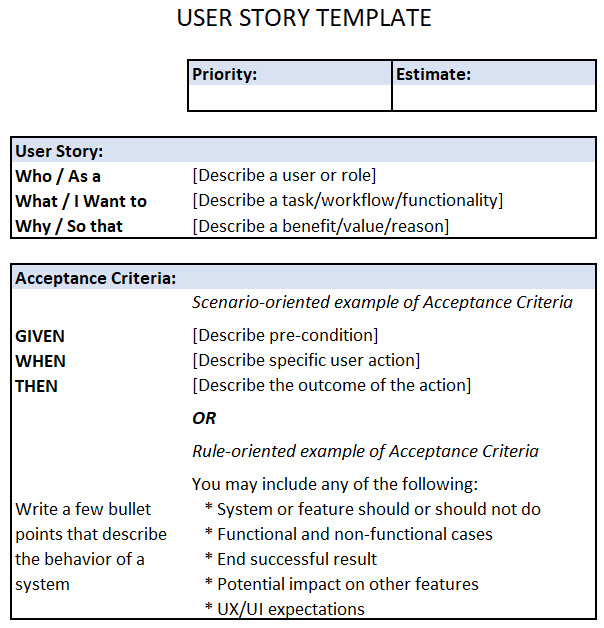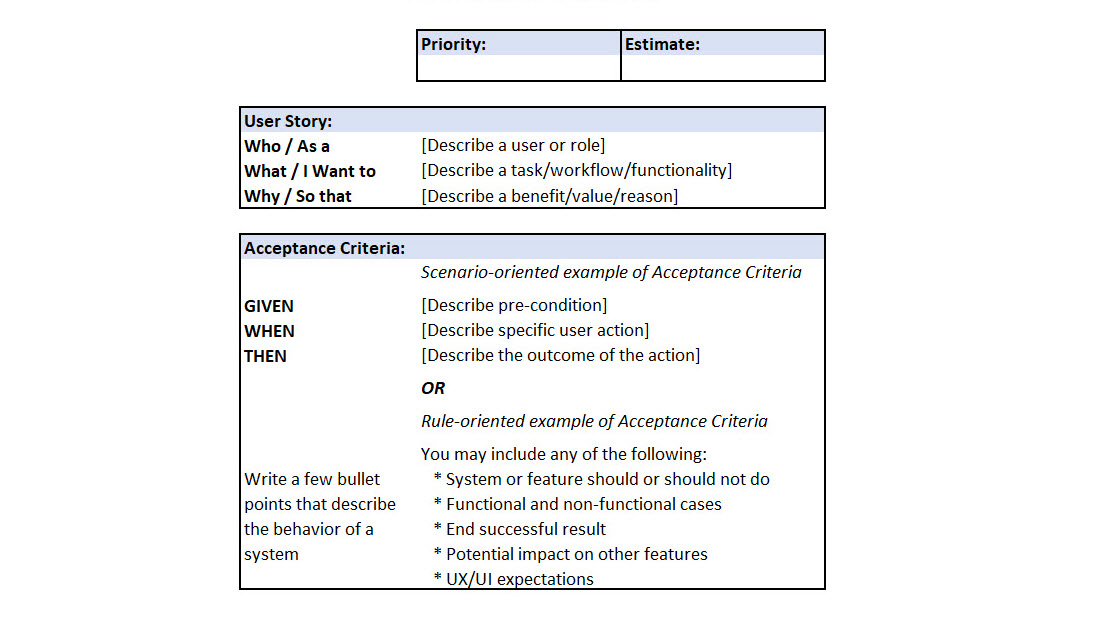Table of Contents
What is a User Story?
User Story is a popular agile methodology tool for describing a feature or requirement from an end user’s perspective. They provide a simple, concise way to capture the needs of stakeholders and guide the development process.
User stories typically include the following components:
- User role: The type of user who will be using the feature. This could be a customer, an employee, or any other type of user.
- Goal: The objective or desired outcome that the user wants to achieve by using the feature. This should be specific, measurable, achievable, relevant, and time-bound (SMART).
- Benefit: The value that the user will derive from achieving the goal. This could be an increase in efficiency, improvements in productivity, or any other benefit that is relevant to the user.
- Acceptance criteria: To consider the feature complete and acceptable, it must meet specific conditions. Defining these conditions is done in collaboration with the development team to ensure that everyone has a clear understanding of what the end user needs are.
- Priority: The importance of the user story relative to other stories. This helps with prioritizing development efforts and ensures that the development team is working on the most valuable features first.
User Story Examples
The most common way to write a user story is as follows:
As a [user role], I want [goal], so that [benefit].
For example:
As a customer, I want to be able to easily search for products by category, so that I can quickly find what I’m looking for.
You can see that this format captures the user’s role, the goal they want to achieve, and the benefit they will derive from achieving it. It’s concise and easy to understand, making it a popular choice for agile development teams.
However, it’s important to note that the format of the user story is less important than its content. The key is to ensure that the user story accurately captures the needs and goals of the user in an actionable way for the development team. As long as the user story is clear, concise, and focuses on the user’s needs, the development team can adjust the format to suit their needs.
From my experience, the Who, What, Why format is a better way to structure a user story, in which the story is broken down into three parts:
- Who: This is the user or stakeholder who has a need or a problem.
- What: This is the action or feature that the development team needs to develop to address the user’s need or problem.
- Why: This is the reason or benefits behind the need or problem that the user is trying to solve.
For example, a user story written in the Who, What, Why format could look like this:
Who: As a marketing manager
What: I want to be able to see a dashboard of real-time campaign performance data
Why: So that I can quickly identify any issues or opportunities and make data-driven decisions to optimize campaign performance.
This format is similar to the As a [user role], I want [goal], so that [benefit] format, but it may be easier for some teams to understand and use.
Ultimately, the key is to use a user story format that works best for your team and accurately captures the user’s needs and goals.
Below is an example of a user story card. You can see that the Acceptance Criteria are part of the user story. I like using the two options for writing acceptance criteria depending on the nature of the story.
- Scenario-oriented: This option is best for workflows or step-by-step processes. The GIVEN-WHEN-THEN structure was first invented for writing down test cases but works perfectly with defining the acceptance criteria. On top of this, the development team can use it to write their tests in the code.
- Rule-oriented: This option is best for a general description of what the result should be.

Downloadable Templates
Best Practices for Creating a User Story
- Focus on the user: User stories should be written from the perspective of the user, not the development team. This helps to ensure that the development team designed the feature with the user’s needs in mind.
- Keep it simple: User stories should be concise and easy to understand. Avoid technical jargon and focus on the key elements of the feature.
- Collaborate with the team: User stories should be created with the development team. This helps to ensure that everyone has a clear understanding of what the team needs to deliver and can work together to achieve the desired outcome.
- Use a consistent format: Use a consistent format for all user stories to make them easy to read and understand. This can also help with prioritization and planning.
- Test and iterate: User stories should be tested and iterated as needed to ensure that they are delivering the desired value to users. This helps to ensure that the development process is agile and responsive to changing needs.
Let me know in the comments what user story format you use.



1 comment
[…] User story templates are a useful starting point for software development teams to create effective and consistent user stories. These templates can help ensure that user stories are structured clearly and concisely, which can make them easier to understand and implement. […]
Comments are closed.